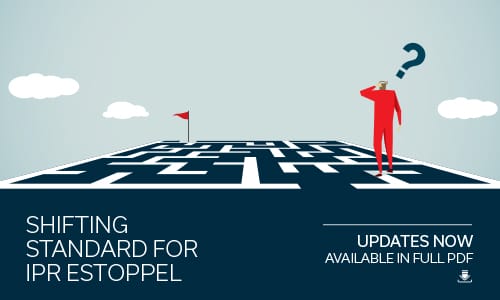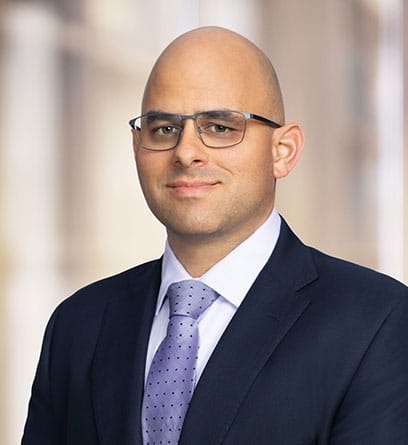After you’ve read this article, please see the latest article in this series, IPR estoppel: A broad interpretation prevails, which provides an update on IPR estoppel through April 2020.
In March 2017, I reported on the shifting standard for estoppel in inter partes review (IPR) proceedings. See The shifting standard for IPR estoppel: Where are we now? In September 2017, I provided another update. SeeAn update on the shifting standard for IPR estoppel. While those articles go into greater detail, district courts have been split as to the scope of IPR estoppel under 35 U.S.C. § 315(e)(2). Unfortunately, over a year later, not much has changed. Nonetheless, a revisit of the issue may be helpful, along with an analysis of the related IPR estoppel before the Patent Trial and Appeal Board (“PTAB” or “Board”), which was not discussed in the previous articles.
Background
The Federal Circuit strictly interpreted § 315(e) in Shaw Indus. Group, Inc. v. Automated Creel Systems, Inc., 817 F.3d 1293, 1299-1300 (Fed. Cir. 2016), and thus arguably held for very narrow IPR estoppel. In that case, where the PTAB had instituted IPR on some (but not all) grounds raised in the IPR petition, the Federal Circuit indicated that estoppel does not apply to prior art raised in non-instituted grounds. As the Federal Circuit held in a subsequent case, “the non-instituted grounds do not become a part of the IPR. Accordingly, the non-instituted grounds were not raised and, as review was denied, could not be raised in the IPR. Therefore, the estoppel provisions of § 315(e)(1) do not apply.” HP Inc. v. MPHJ Tech. Inv., LLC, 817 F.3d 1339, 1347-48 (Fed. Cir. 2016) (citing Shaw, 817 F.3d at 1299-1300). That is, the Federal Circuit took a literal interpretation of the statute, which refers to grounds that the petitioner “raised or reasonably could have raised during that inter partes review” (as opposed to those that were raised or could have been raised in a petition for inter partes review).
In Shaw and HP, the Federal Circuit technically analyzed 35 U.S.C. § 315(e)(1), which relates to IPR estoppel before the PTAB, e.g., estoppel in subsequent IPR proceedings. On the other hand, 35 U.S.C. § 315(e)(2) relates to IPR estoppel before district courts, e.g., in co-pending or subsequent infringement actions. The scope of IPR estoppel between the two, however, should be identical. Both use the same language, applying estoppel with respect to “any ground that the petitioner raised or reasonably could have raised during that inter partes review.” 35 U.S.C §§ 315(e)(1) and (e)(2).
Despite the Federal Circuit’s decisions that seemingly provide a very narrow scope for IPR estoppel, only some district courts have followed that approach. Other courts have found ways to distinguish these cases to provide for a broader IPR estoppel, which is arguably more in line with the legislative history. Similarly, the PTAB has also provided for broader estoppel.
Narrow estoppel
After my September article, another district-court judge literally interpreted Shaw and HP as providing for a very narrow scope of IPR estoppel. See, e.g.,(Koninklijke Philips N.V. v. Wangs Alliance Corp., 2018 WL 283893, at *4 (D. Mass. Jan. 2, 2018). Under this judge’s interpretation, IPR estoppel does not apply to prior art not included in an instituted ground, regardless of whether it was actually included in the IPR petition. This follows under Shaw’s reasoning because in instituting an IPR, the Board typically limits the proceeding to some or all of the claims and prior art specifically included in the petition. Typically, the petitioner is not able to raise arguments based on different prior art not included in the institution decision. Thus, after the Board enters a final written decision, it logically can be said that the petitioner couldn’t have raised any other non-instituted prior art during the IPR, and thus IPR estoppel does not apply to such other art.
Of course, this view does seem to contradict the legislative history discussed in my May article, and makes the estoppel provision of § 315(e) very weak. Indeed, the District of Massachusetts recognized this, stating “[t]here is much appeal in a broader reading of the estoppel provision.” Ultimately, however, the court found that this “broader reading of the estoppel provision is foreclosed by Shaw.”
Tallying up the cases discussed in this series of IPR estoppel articles, judges in at least the following districts have literally interpreted Shaw and found for a narrow scope of estoppel as of the present time: District of Massachusetts, Northern District of California, and District of Delaware (although there is an intra-district split in Delaware). Despite being based upon the Federal Circuit’s Shaw decision, this currently appears to be the minority view.
Broad estoppel
With respect to the broad view for IPR estoppel since September, the Eastern District of Texas continues to take that approach, limiting both Shaw and HP. See Network-1 Techs., Inc. v. Alcatel-Lucent USA, Inc., 2017 WL 48556473 (E.D. Tex. Oct. 27, 2017). As in the past, this case found that Shaw provides only a very narrow exception to IPR estoppel. Under its interpretation, prior art that could have been raised in a petition—but was not—is estopped. Shaw’s exception, according to this view, is for art that was actually raised but rejected by the PTAB. (As discussed in the September article, one Texas decision limits Shaw even further, holding the exception only applies to art actually raised but rejected on procedural grounds, as opposed to art rejected on the merits. The Network-1 decision did not address that aspect though.)
Adding up the articles discussed in this series of IPR estoppel articles, judges in at least the following districts have narrowly interpreted Shaw and/or found for broader estoppel: Eastern District of Texas, Northern District of Illinois, Eastern District of Wisconsin, Western District of Wisconsin, Middle District of North Carolina, and District of Delaware (although there is an intra-district split in Delaware). As such, this is currently the majority view, even though one could argue the majority view contradicts the Federal Circuit’s Shaw decision.
Looking outside of the district courts, the patent office and the PTAB have also limited Shaw and applied a broad standard for IPR estoppel under the closely related 35 U.S.C. § 315(e)(1). See, e.g.,Great West Casualty Co. v. Intellectual Ventures II LLC, Case IPR2016-01534, Paper 13 (PTAB Feb. 15, 2017). In this case, the PTAB specifically rejected the argument that Shaw limits § 315(e)(1) to “grounds actually raised during the prior completed proceedings,” as that argument would render superfluous the statutory words of “or reasonably could have raised.” Thus, the panel in this case limited the Shaw exception to grounds actually “presented in a petition, but denied institution.” This case, , is not precedential, so it is possible that a different panel could reach a different outcome. It is also possible that the PTAB could simply use its discretion under 35 U.S.C. § 314(a) and General Plastic Industrial Co. v. Canon Kubshiki Kaisha, Case IPR2016-01357, Paper 19 (PTAB Sept 6, 2017) (precedential as to Section II.B.4.i)to deny such a follow-on petition in order to avoid even needing to decide the estoppel issue.
Also notable is that the Director—via the Office of Patent Legal Administration—reached the same outcome as Great West in an order vacating an order granting ex parte reexamination. See In re Raynaud, Control No. 90/013,824 (Dec. 15, 2016). There, an ex parte reexamination was terminated with respect to claims that had also been part of an IPR based upon IPR estoppel under § 315(e)(1). Unlike the PTAB’s decision in Great West, the patent office in this order did not consider the Shaw decision, and so the requester filed an action in the Eastern District of Virginia challenging the order on that basis. That challenge failed, because the district court found judicial review is precluded for a decision not to institute an ex parte reexamination (including where based upon an estoppel determination). See Synopsys, Inc. v. Matal, 280 F. Supp. 3d 823 (E.D. Va. Nov. 15, 2017).
Conclusion
As before, the scope of estoppel under 35 U.S.C. § 315(e)(2) depends upon the district and the particular judge to which the case is assigned. More courts, however, appear to be applying a broader scope for IPR estoppel. Similarly, although there have not been many cases and they are not precedential, the patent office has (so far) also ruled for broad IPR estoppel under 35 U.S.C. § 315(e)(1).
It is only a matter of time, however, before the issue reaches the Federal Circuit and the standard is clarified. Until then, the best practice continues to be for petitioners to err on the side of caution and assume that anything that could have been raised in the petition will be estopped in subsequent district court litigation and PTAB proceedings.
Tony Blum represents clients before the USPTO in post-grant proceedings and litigates patent infringement suits throughout the country.


